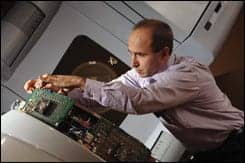 In preparing for x-ray topics in the CBET exam, you might begin with an article I wrote on x-ray in the April 2010 issue of 24×7 (“Radiology”). Once you’ve read it, return to this article for some key additional x-ray topics: fluoroscopy, photo timing, and radiation safety.
In preparing for x-ray topics in the CBET exam, you might begin with an article I wrote on x-ray in the April 2010 issue of 24×7 (“Radiology”). Once you’ve read it, return to this article for some key additional x-ray topics: fluoroscopy, photo timing, and radiation safety.
Fluoroscopy
Fluoroscopy is known as a real-time imaging technique. It allows a physician to image moving internal structures for diagnostic purposes. Fluoroscopy—or fluoro, as it is often called—uses an x-ray tube, most often mounted within the table, to shoot an x-ray beam up though the patient to an image amplifier (IA) or image intensifier (II) mounted above the table. The IA or II devices take a low-level radiation signal and turn it into visible light for viewing on a monitor.
Many changes in this technology have occurred as radiology has evolved to the filmless images of today. I don’t foresee the CBET exam delving into these types of technology changes, since the Certification for Radiology Equipment Specialists exam is more suited for questions about these changes.
As mentioned, in contrast to over-the-table tube procedures, flouro emits relatively low-level radiation. The reason for this is that the time the patient is exposed to the radiation is considerably longer than with a regular radiation shot or exposure. For standard flouro studies, radiation exposure is limited to 10 R/minute at the tabletop. For high-line or cine, the limit is 20 R/minute.
The applications where you may be most familiar with using fluoro may be barium studies, used for upper or lower gastrointestinal (GI) diagnostic procedures. Barium is a radio-opaque die that allows highlighting of internal GI structures such as the intestines. As the radiation is shot through a patient who has been given barium, the x-ray beam is blocked from going through the barium. This blockage of the x-ray beam through the structure in which the barium is located shows up as a dark structure, because no radiation is received by the image receptor.
This technique is widely used to see if there are blockages or perforations to the intestinal tract. Typically, a physician would watch the barium travel along the intestines using flouro until a point of interest is noticed. At this point, a “spot film” may be taken by the physician. Once a spot film is asked for, the x-ray tube’s output is increased enough to make a regular x-ray photo, and the II or IA is not used. In the flouro mode, a time limit of 5 minutes is employed to help the physician keep track of how long the patient is being exposed. Once this time limit is reached, an alarm will sound to indicate time of exposure to the patient.
Photo Timing
Flouro back-up timing should not be confused with photo timing, which is a totally different technology application. Photo timing is used to terminate exposure after a predetermined amount of x-ray has been received. It may also be referred to as automatic exposure control. Photo timing uses either ion chambers or newer solid-state detectors to terminate exposure when enough radiation to make an image of diagnostic quality has been detected. This ensures that the radiograph is of the correct density or has enough film blackening to enable a diagnosis.
With photo timing, the patient rarely has to be reimaged because of lack of radiation received by the receptor. An ion chamber is used in this technology because it will produce a current when struck by ionizing radiation. This current is used to produce a voltage. When the voltage reaches a predetermined amount, the exposure is terminated. With this technology, good images are not dependent on operator technique.
Radiation Safety
Radiation safety as it pertains to the CBET exam has mostly involved time, distance, and shielding. The radiologist and radiology technicians are protected by wearing exposure-monitoring devices. Film badges are an older technology used to monitor radiation exposure. Newer techniques, such as thermoluminescent dosimetry, and optically stimulated luminescence, are employed widely today.
For simplicity, I will explain how a monitoring device works using the older technology of a film badge. In this device, a piece of x-ray film is placed behind a material of varying thickness. The more the badge is exposed to radiation, the more the film in the thicker portions of the badge will be exposed. If no exposure gets to the film at the thickest portion of the “step wedge,” this indicates less exposure to the person wearing the badge. The newer technologies work basically on the same principle. They indicate radiation exposure over a period of time, usually a month. Newer monitoring devices, however, can be quarterly.
What You Should Know
To do well on the certification exam, you probably need to know the difference between a standard radiograph and a flouroscopy image. Remember, flouro is real-time imaging of a structure, and is used often in upper and lower GI studies. Photo timing is another area you should know about. It is used in a radiographic technique to determine how long an exposure needs to be to form a diagnostic-quality image, and thus to avoid exposing the patient a second time. Finally, you probably need to know how the personnel in the imaging department are monitored for exposure to radiation through film badges and other devices.
Although each of these subjects is much more complex than I can do justice to here, I believe this level of understanding will be suitable for the CBET exam. I hope you find this information useful in your quest to become certified.
Review Questions
1) Radiation film badges are used to:
a) Determine exposure to imaging personnel
b) Gain entrance into the imaging department
c) Terminate x-ray exposure
d) Guarantee quality x-rays
2) Photo timing is used to:
a) Keep the physician aware of how long a patient has been exposed to radiation
b) Terminate x-ray exposure
c) Determine proper technique
d) Count the number of photons in the primary beam
3) Fluoroscopy is a(n):
a) High-radiation exposure technique
b) Low-radiation exposure technique
c) Ultrasound technique
d) Process that uses a Doppler shift
4. Ion chambers are used in which imaging technology?
a) Ultrasound
b) Nuclear medicine
c) AEC
d) Fluoroscopy
John Noblitt is the BMET program director at Caldwell Community College and Technical Institute, Hudson, NC. For more information, contact editorial director John Bethune at [email protected].
Answers: 1—A, 2—B, 3—B, 4—C
UPDATE June 24, 2014: The answer to question 2 in the quiz was corrected. The correct answer is not A, “Keep the physician aware of how long a patient has been exposed to radiation” but B, “Terminate x-ray exposure.”





Question #2…answer A?!? Photo timing cuts off exposure when appropriate radiation level has been reached to meet need, “Photo timing uses either ion chambers or newer solid state detectors to terminate exposure…” (article). Shouldn’t answer be B?
Frank,
You are absolutely right! We apologize for the typo, and have corrected the error accordingly.
John Bethune
Editorial Director, 24×7